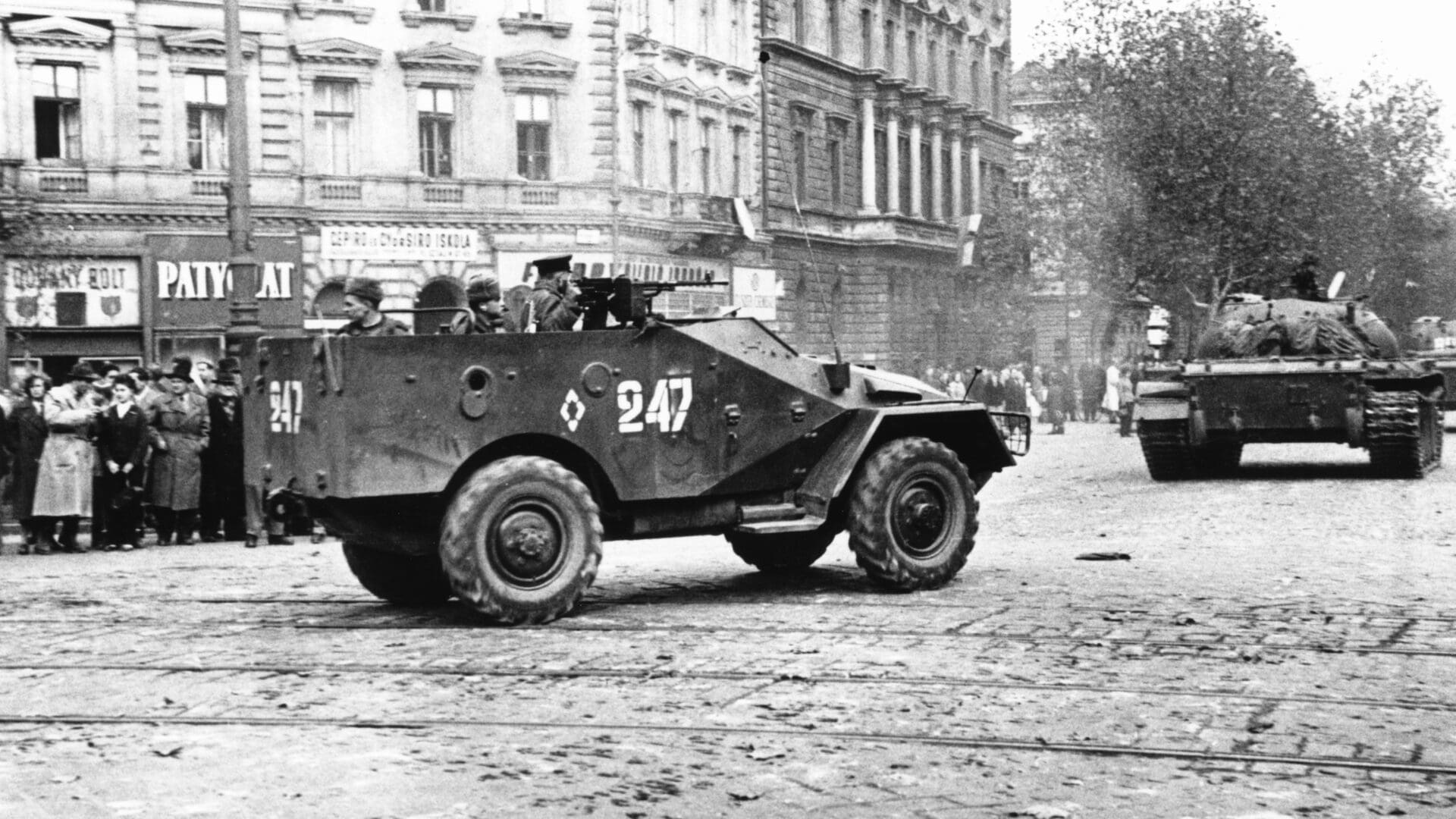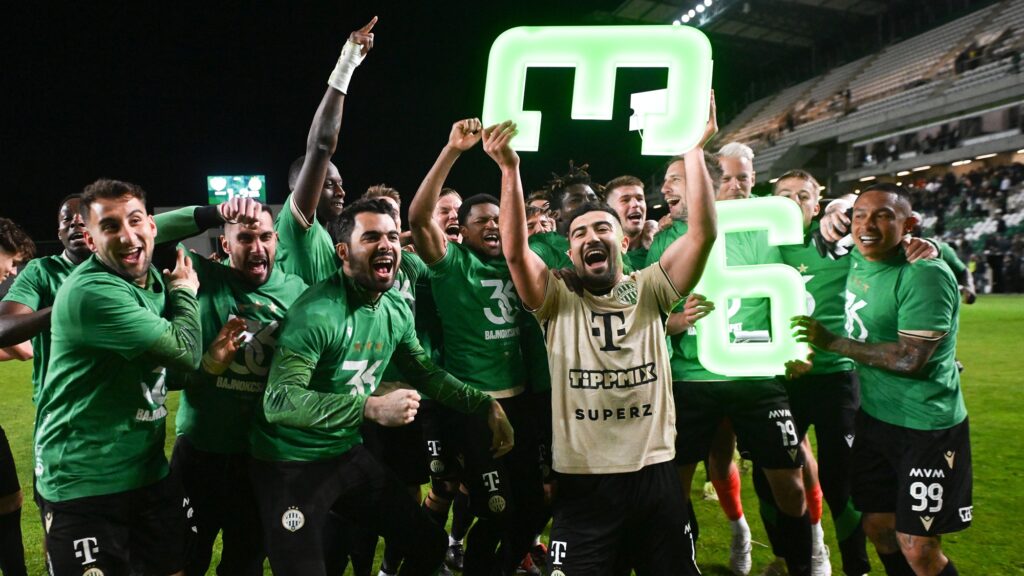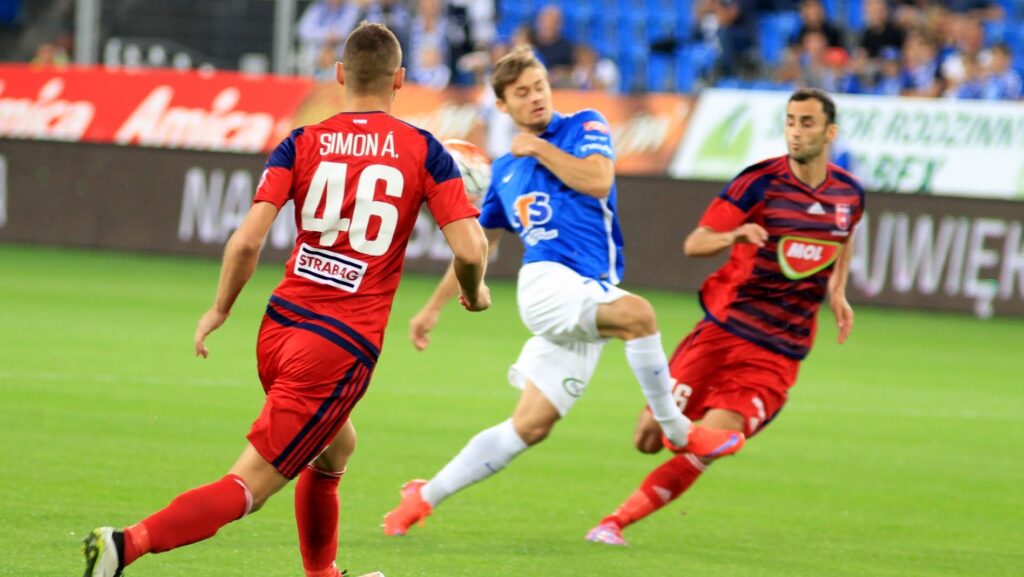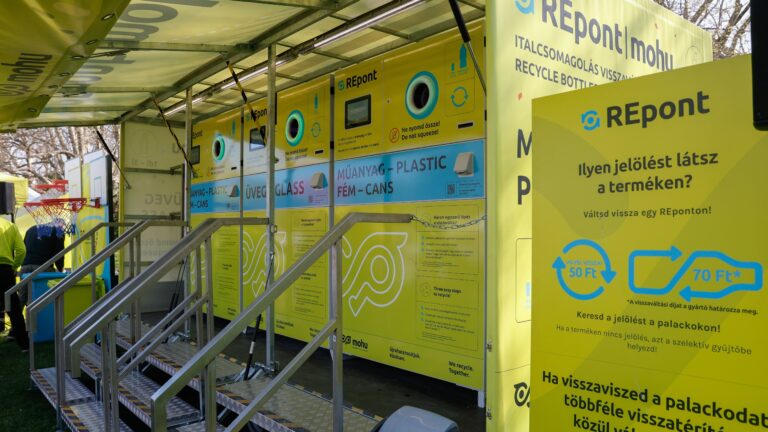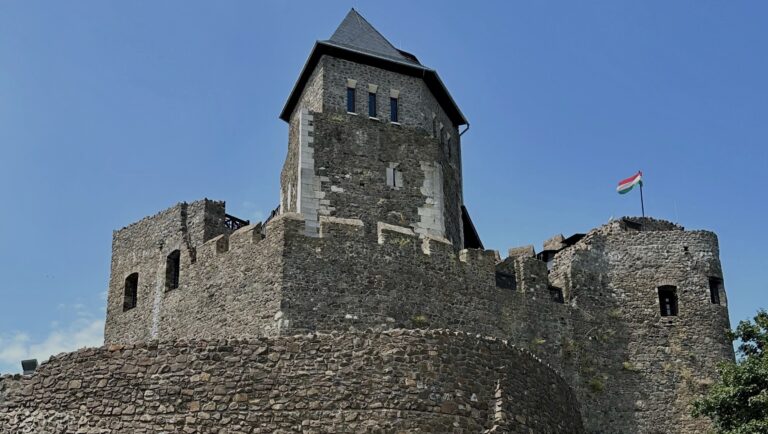This is an abridged version of an article first published in the Hungarian Review on 4 November 2016.
At noon on 31 October 1956, the streets of Ferencváros, like the rest of the Budapest, were free of fighting. The Red Army, who twelve years before had smashed its way into the city, was gone. It had been just a week earlier that the Soviets had deployed their 92nd Armoured Division to the capital, from its base in Székesfehérvár 70 kilometres to the south-west. They had come in response to dramatic demonstrations against the Hungarian Communist regime and the initial invitation of its head, Ernő Gerő.
But the Soviets, to their considerable surprise, had encountered stiff armed resistance to their intervention, and, over the following seven days, were unable to overcome it. This resistance most notably coalesced around the Corvin cinema, which sits where the boulevard circling inner Pest meets Üllői út, the road leading south-east towards the airport. Heading down that road from the Corvin immediately takes you into the 9th district, Ferencváros, whose own notable fighting groups remained undefeated as the Soviets completed their withdrawal that morning. Was this victory?
You might assume that this was no time to think about something as trivial as football, but you would be quite wrong.
On the same day, a revolutionary committee took charge of the central body that the Communist regime had appointed to micro-manage Hungarian sport on its behalf, the OTSB. Back in 1950, the OTSB had turned the people’s game on its head, imposing new identities on the nation’s biggest football clubs, including its most famous and popular one—Ferencváros (FTC). In the middle of that extraordinary 1949/50 season, the club formed in 1899 and colloquially known as Fradi suddenly became the team of the food industry’s union; it was renamed ÉDOSZ and had its iconic green and white kit changed to a Party-friendly red and white. But with football freed from party-state control on 31 October 1956, Fradi could return.
So it was that thousands gathered the following day at Ferencváros’ stadium to celebrate the re-formation of a football club. It was a moment and a process that was, in many ways, far more typical of the uprising than the street fighting that had taken place in that district a few days earlier and would soon resume. The thirteen days of the revolution was characterised by two dovetailing elements central to Fradi’s return: on the one hand, the re-establishment of forms and identities that had been buried in the Communist Party’s early, Stalinist years of control in Hungary between 1949 and 1953; and, on the other hand, the emergence of new anti-regime bodies which swiftly took control of most areas of national life, in place of the regime’s rapidly crumbling authority. Revolutionary committees took the reins of governments in cities, towns and villages across Hungary, while similarly anti-regime workers’ councils assumed control of factories and plants, demonstrating the emptiness of the ruling Party’s claims to represent the working class.
Suppressing, renaming, replacing, appropriating; these had all been tactics of the Hungarian Communist regime led by Mátyás Rákosi, in its haste to remake the nation in its own image. With will, power, and the mystical tide of history on their side—the ascendant Stalinists assumed in the early fifties—old forms, identities, connections, ways and ideas could be irrevocably consigned to oblivion. And that is why every revivification of an old name or practice in the uprising was so significant; each instance was a celebration of the fact that the regime had not succeeded. Cherished loyalties and meanings had not in fact disappeared beneath arbitrarily imposed replacements. They had not been forgotten. They were not dead.
Football was the perfect microcosm of the Party’s failure to create permanent felt realities beneath its fiat impositions because
it was the emotional pull and socio–political significance of football that had persuaded the Party to try utilising it in the first place.
The rapid unravelling of this project in the uprising also saw two of the other big Budapest clubs that had received new identities in the 1949/50 season restored: Újpest TE and MTK returned to life under their ancestral names. The exception was Honvéd, who, with a European Cup tie against Athletic Bilbao approaching, retained its new form. Nevertheless, after 31 October, newspapers quickly in the habit of reverting to pre-1950 titles also began referring to Honvéd by their former identity of Kispest. At the same time, the revolutionary committee freshly in charge of the OTSB indulged in some renaming of its own. The vast concrete-bowl national stadium that the Communist regime had built and opened three years earlier as Népstadion (People’s Stadium) would, the committee announced on 1 November, henceforth be known as Ifjúság Stadionja (Youth Stadium) in honour of the many young people who had fought in the uprising.
The football clubs founded at the end of the 19th century, particularly in Budapest, were from the beginning freighted with both organic and contrived significance. Therefore, the likes of the Ferencváros and Újpest clubs were not only founded to represent and reflect their respective areas but were also aspirational organisations. Their adoption of the word Torna (gymnastics) gave them overtones of moral and civic engagement in a Central European context where the German Turnverein and Czech Sokol gymnastic movements were vehicles of national idealism. These clubs were also being formed at a time when the Hungarian government, which had possessed a wide degree of autonomy within the Habsburg realms since the 1867 Ausgleich, was increasingly seeking to Magyarise the Kingdom of Hungary, a territory whose population was about 50 per cent non-Magyar. This cultural and linguistic agenda gave members of non-Magyar ethnicities, particularly in cities, significant incentive to emphasise their participation in the dominant national community.
But foundational differences between Ferencvárosi TC and MTK, in particular, would not have played such a large part in the subsequent story of Hungarian football were it not for the remarkable fact that no other team won the championship between 1903 and 1929. Despite the genuine, though generalised, distinctions between the fan bases and identities of these two clubs, the long rivalry and the emergence of football as a mass spectator sport exaggerated them far beyond any underlying reality. This became especially the case, with sad consequences for both clubs, of the Jewish–Gentile divide. MTK was never a Jewish club or team in the way that the great Hakoah Vienna was, while Fradi had Jewish founders, fans and directors. Yet the over-emphasis on this aspect of the Fradi–MTK split was nevertheless exacerbated in the inter-war years.
The Great War and subsequent treaties had rendered Hungary a rump state, denuded of two-thirds of the kingdom that lived on only in the inter-war leader, Miklós Horthy hypothetical role as regent. As a result, the new, smaller Hungarian body politic was both more ethnically homogeneous and burdened with a sense of loss. As was the case across the region, this was also accompanied by rising anti-Semitism, which was translated into restrictive legislation against Hungary’s large Jewish population. Finally, after the Second Jewish Law of May 1939 greatly restricted the participation of Jews in the economy, the management of MTK (which had renamed itself Hungária in 1926) was handed over to a right-wing chairman. After finishing second to Fradi on goal difference in the subsequent 1939/40 season, as Hungary’s German allies were rapidly occupying Central and Western Europe, the club was shut down entirely.
So while it was certainly true, in historian Győző Molnár’s words, that ‘before Communism each football team had its unique social connotation and groups of fans’, those identities were neither simple nor uncontested; they were subject to both exaggeration and corruption. Yet when [after WWII] the national league finally fully resumed for the 1946/47 season, it was reassuringly once more dominated by the old guard of Pest-based sides. That included MTK, back with their original name and playing at their old stadium between Fradi to the south and the forthcoming national stadium to the north. And in 1947 the revived MTK signed a young player, Nándor Hidegkuti, whose name now adorns that ground on Hungária Boulevard. Six years after he joined the blue-and-whites, he would score a Wembley hat-trick that brought Hungary glory across the football world.
One could be forgiven for thinking that the political upheavals and manipulations that had scarred the game in the late thirties and during the war were over. But of the six Pest teams that filled the top six positions at that 1946/47 season’s end, only Vasas—the team of the ironworkers of Angyalföld with its solid left-wing history—would emerge unscathed from the Communist takeover.
Two aspects of this new regime sealed the fate of football. Firstly, as was the case across the new Soviet bloc, it was de rigueur for the Hungarian party-state to slavishly ape every aspect of the Soviet precedents. In the case of football, this would mean
welding existing football clubs onto departments of state and trade unions without any regard to history and culture.
For about a year it seemed that football had escaped close scrutiny. The national sporting body was overseen by the Ministry of Culture, while more easily contrived and controlled activities drew its attention. But the first dramatic indication of a fundamental reorganisation of football came two games
But indication a fundamental reorganisation of football came two games shy of the 1949/50 season’s halfway point, when Kispesti AC was suddenly placed under the jurisdiction of the Ministry of Defence, and renamed Honvéd SE (Sportegyesület). Due to the crucial role it would play in the formation of the legendary national team that the English call the Mighty Magyars (and the Hungarians refer to as the Aranycsapat (Golden Squad), Honvéd is usually as far as foreigners explore Hungarian club football of this era. But, while the ability to draw on all members of the armed forces in a time of universal national service was certainly an incredible advantage for Honvéd, this focus obscures the pre- nationalisation roots of its success.
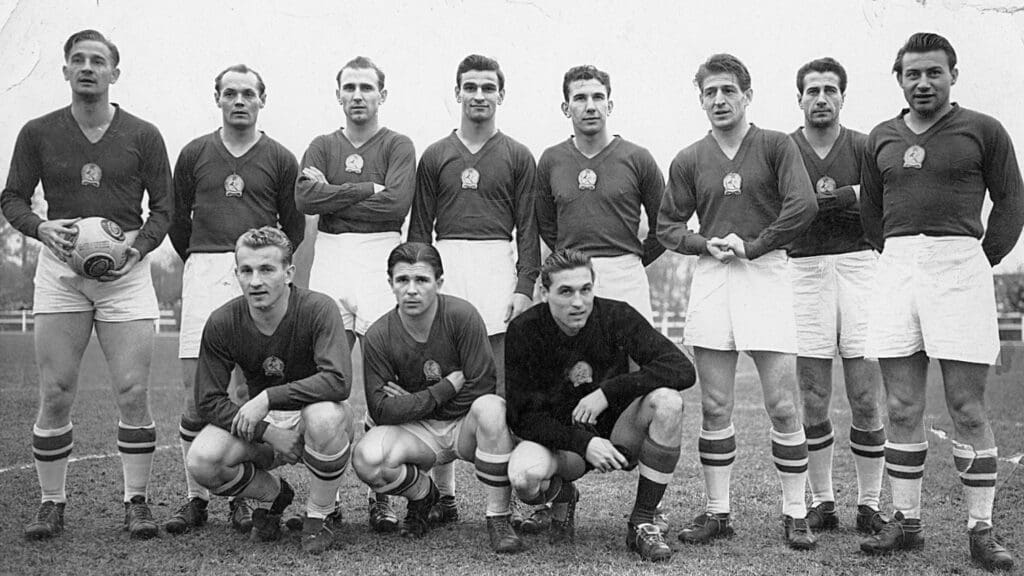
The transformation of the Kispest club’s fortunes under the appropriation and sponsorship of the Army has been greatly exaggerated both at home, by understandably aggrieved fans of other clubs, and abroad. It did not turn Kispest from an obscure backwater club into the champions; it turned them from one of the best teams in the country into the very best. The base of a great team was there prior to the takeover, partly thanks to the felicity that both Ferenc Puskás and József Bozsik were Kispest boys who naturally played for their local club.
In the 1930s, Kispest had been competitive yet perennially stuck behind the traditional top teams that dominated Budapest and, therefore, Hungary. But in the first Hungarian national championship since the war, 1946/47, Kispest had finished second, behind Újpest but ahead of Fradi and MTK. That year, Puskás scored 32 goals in the league, and the following season he scored an incredible 50.
And the 1949/50 season looked like it was going to be the best in the club’s history. On 13 December 1949, Kispest beat Soroksár 6–1 to maintain a slender lead over Budapest rivals MTK and Ferencváros at the top of the table. With thirteen games played, Kispest were on course for their first ever Hungarian championship. But one week later, the name of Kispest was not only no longer in first place, it was nowhere to be found on the league table. In the official account, the club that now led the league, Honvéd SE, had ‘merged’ with Kispesti AC. But this was a takeover. And it was a sign of things to come.
During the mid-season winter break, on 13 January, the regime established a new national sport authority. Significantly, rather than remaining under the Ministry of Culture, the OTSB (Országos Testnevelési és Sportbizottság: National Physical Education and Sport Committee) was placed directly under the supervision of the cabinet. It signalled the complete nationalisation and centralisation of sport, and when, at the end of February, the football season resumed, the consequences were clear. Just a few years after being snatched from oblivion, MTK was placed under the Textile Workers’ Union and given the bland new name of Textiles, while its colours were predictably switched from the traditional blue and white to, you guessed it, red and white.
At the same time, as previously mentioned, Fradi suffered a similar fate, becoming the red-and-white clad ÉDOSZ (Élelmiszeripari Dolgozók Országos Szakszervezete: National Trade Union of Food Industry Workers). With Hungary’s three top clubs renamed and appropriated, all that remained—a few weeks after the season had so bizarrely re-started—was Újpest’s transformation. The oldest club in the first division finished the season as the team of the police force, under the supervision of the Ministry of Interior and with the non sequitur name of Dózsa SE.
This was ultimately an expression of power by the regime. But it was also a mark of extraordinary confidence in its ability to both sweep away ties that historically bound clubs to people and places and replace them—while retaining the vibrancy and passion that animated the original connection—with identities of the regime’s choosing. No doubt conscious that ÉDOSZ was as uninspiring a name as could be imagined, the authorities once more re-christened the former Fradi after the semi-season that followed the momentous changes of 1949/50. When the full 1951 season arrived, ÉDOSZ had become Budapesti Kinizsi (like Dózsa, whose name now adorned the Újpest team, Kinizsi was a fifteenth-century Hungarian hero of whom the Communists approved). To some degree, it was to be expected that the former Fradi and its fans, who were under the suspicion of the regime for their nationalist connotations, would be subject to radical transformation. Yet it was once again MTK who fared the worst in the upheaval; this time inadvertently.
In years to come, after the restoration,
Ferencváros fans would wear their club’s maltreatment as a badge of honour.
No such emotional catharsis was available to MTK who, after spending 1950 as Textiles, were turned in 1951 into the club of the dreaded and detested secret police: the ÁVH (Államvédelmi Hatóság – State Security Authority). Under this sordid new sponsorship, the former MTK became Budapesti Bástya (Bastion), finishing that 1951 season as champions. Two years later, the club was, absurdly, renamed yet again as Budapesti Vörös Lobogó (Red Flag), condemned to sounding more like a socialist newspaper than a football club. So poisonous was the link with the ÁVH that this proved to be the Stalinist- era transition with the most enduring and deleterious effects. It sucked away the opportunities for emotional, joyous connections between supporter and club that make football a cultural phenomenon, leaving MTK, even today, a club with a great heritage and often a good team, but few fans.
In the end, the top-down transformation of Hungarian football between 1949 and 1953 did not leave a taste of idealism, misguided or otherwise, but of wanton and arbitrary coercion, poorly thought-through and speedily executed.
In the context of a nation in which identities and names had already been scrambled by a mixture of upheaval, choice and survival strategies, it was unusually conceivable and pertinent for the new Communist regime in Hungary to impose its own new set of identities in the ‘zero hour’ of post-war Europe.
The shifting parameters and meanings of ethnicities and nationalities was the forge of many new identities. Consider, for example, the leaders of the Communist Party themselves. Mátyás Rákosi, his successor Ernő Gerő, and the executed László Rajk* were all born in Hungary. Yet in adulthood, after the First World War, their hometowns were in Hungary no longer, but instead in Yugoslavia, Czechoslovakia and Romania respectively. Gerő’s and Rajk’s towns of birth also had their names changed to reflect the ethnicity of the nation-states to which they now belonged. The strange disorientation that this gave these men who regarded themselves as Hungarian, but suddenly were no longer ‘from’ Hungary, was mirrored in the country as a whole, which just as suddenly went from being a multi-ethnic kingdom to a far more homogeneous nation-state which regarded its true borders as exceeding its political ones. This same transition was doubly difficult for these three, and many like them, because as Jews (Rákosi and Gerő) and a Transylvanian Saxon (Rajk), their Hungarian-ness was put in doubt by the more stringently ethnic criteria that this situation had encouraged. All three adapted by changing their own names to more ‘Magyar-sounding’ monikers: they had been born as Mátyás Rosenfeld, Ernő Singer and László Reich.
The man who succeeded Rajk as Interior Minister and eventually led Hungary for more than thirty years, János Kádár,
was still known by his real name of János Csermanek as late as 1945.
Kádár had been born in the Hungarian crown’s Croatian port city of Fiume, which itself passed through many hands and is now Rijeka. And it was not just Hungarians born in the since amputated regions of the old kingdom who found themselves faced with the urge to grant themselves a new identity that chimed more with a changed nation’s mood. Just as Budapest had a large, old Jewish community (which had emerged from the Holocaust in Hungary in greater proportions than their decimated equivalents in the rest of the country), it also had long been home to ethnic Germans, particularly Swabians. They, too, often gained new names.
One of them was a footballer from Kispest named Ferenc Purczeld, whose father, when the player was still a boy, changed the family name to Puskás.
As the crucial month of November 1956 began, both these men, Kádár and Puskás, departed Hungary and journeyed into very different places in Hungarian history. Puskás left with his teammates for Vienna on 2 November (the MTK squad also went to Vienna on the same day) to begin a tour of Germany, Belgium and France in the run-up to the Bilbao tie. The greatest of all Hungarian footballers would not set foot in his country again for twenty-five years. Meanwhile, late on the previous evening to Puskás’ departure, Kádár left Budapest in the opposite direction, flying to Moscow at the invitation of Soviet ambassador Andropov. Kádár would return rather sooner—three days later, as the Soviet-installed head of a new provisional Hungarian government.
When the uprising began, Kádár was perfectly positioned; neither an inveterate reformer nor a discredited hardliner, he was appointed as the Party’s First Secretary on 25 October when, after a massacre of demonstrators, the Hungarian Politburo panicked and removed the tone-deaf Ernő Gerő.
In the days that followed, as they scrambled to keep up with and modulate popular demands, Kádár and Nagy were the only Communists in the country who seemed to retain any serious credibility. On 30 October (the day on which the coalition cabinet was announced), Kádár headed into the streets with Ferenc Münnich, the current Interior Minister and former President of Fradi, to negotiate with leaders of the armed groups at Corvin and into Ferencváros. Kádár was particularly impressed by his conversation with the Tűzoltó Street fighting group in the 9th district and István Angyal, its leader. Angyal had been one of the many Hungarian Jews who had been deported to Auschwitz in 1944 and, while he was one of the few who returned, his mother and sister had not. Now, faced with Kádár, Angyal insisted that his group were not reactionaries but real revolutionaries, with many of them displaying their membership cards to the Party leader.
These were the sort of men with whom Kádár had to build a new legitimacy. But the scale and nature of that task was clarified on the 31st, with another dramatic act of renaming. In a desperate attempt at renewal, the Party (MDP), so thoroughly discredited by its exposed immersion in deceitful and self-serving terror, was dissolved, and a new Communist Party was launched in its place—the MSZMP (Magyar Szocialista Munkáspárt: Hungarian Socialist Workers’ Party). It was in fact not the first time that Kádár had both dissolved and reformed the Party—as central committee secretary of the tiny wartime Party he had also done so as a tactical ploy—and, astonishingly, the MSZMP became the fifth iteration of the Communist Party within Hungary in just 13 years.
But these hopeful and peaceful hours in Budapest, as the Soviets withdrew on the 31st and reformations and restorations continued across the nation, constituted a false dawn. Even as Fradi supporters rejoiced at their stadium on 1 November,
ten miles to the south-east the Red Army was seizing control of Ferihegy airport.
When it became clear that the Soviets, rather than accepting Hungary’s retreat from orthodox Communist rule, were preparing a new and decisive intervention in Hungarian affairs, Imre Nagy finally aligned himself fully with a central popular demand of the uprising. At 7:50 p.m., the Prime Minister told the nation that Hungary was withdrawing from the Warsaw Pact and appealing to the UN for assistance. But as Kádár’s pre-recorded message regarding the new Communist Party was also broadcast later that same night, the man himself was on his way to Moscow.
Over the next few days, former Presidents of Vasas (Kádár) and Fradi (Münnich) negotiated the shape of a new Soviet-imposed Hungarian government. And after the Red Army launched the overwhelming military operation on 4 November that crushed the popular uprising and made Kádár the head of a new ‘revolutionary workers’ and peasants’ government’, the momentary dream of a restored multi- party democracy disappeared. Strangely, as this took place, Hungary’s greatest sportsmen and women were, almost to a person, elsewhere. The Olympic team’s three-week odyssey to the Melbourne Olympics was underway and it would be a fortnight before they discovered what had transpired back home. Meanwhile, its top footballers, as we have seen, were already scattering across Europe on various European tours. But just as football had been a microcosm of the recovered identities and restored meanings of the uprising, it also demonstrated the ambivalent way in which one-party rule would be restored.
While the Stalinist leaders of the late forties and early fifties had sought to politicise and micro-manage every aspect of national life, Kádár felt his way to an opposite accommodation with society; if people kept away from politics, then politics would be kept away from them. But this was not immediately apparent, and Kádár did not crystallise it with the memorable maxim, ‘those who are not against us are with us’, until 1961. But far sooner football demonstrated the hopeful, yet contradictory, contours of this new bargain. Instead of being condemned to return to the arbitrarily imposed identities of the 1949/50 takeover, Hungarian football’s revolutionary restoration was partially retained.
The protection of what had been regained in the uprising was aided when, on 10 November, the OTSB recommended its own dissolution to the cabinet. It was a self- denying ordinance that the government was only too happy to oblige, as it transferred national oversight of sport back to minor ministries. A week later, bolstered by the demise of the OTSB, the Hungarian FA (MLSZ: Magyar Labdarúgó Szövetség), announced the resumption in 1957 of a standard autumn/spring season, jettisoning the shadowing of the Soviet season that the OTSB had previously introduced, while making a point of insisting that it would be deciding football matters independently.
In November, MTK joined their ancient rivals Fradi in final liberation from the takeover of 1950. At the close of their English tour—after games against Sunderland, Portsmouth, Tottenham, Manchester City, Brighton and Wolves—the club, having played the whole tour as MTK, was officially restored to that former name and freed from the unwanted embrace of the ÁVH. Those final two games, against Brighton (8 December) and Wolves (11 December) even raised money for the Hungarian Relief Fund (the latter amassing the princely sum of £2,312 and 2 shillings for the cause).
Meanwhile, on tour in Yugoslavia, Ferencváros played its first game as FTC and in green-and-white since 1949, taking on Vojvodina. But amidst the catharsis of familiar names and identities restored, there was lingering discord.
Újpest was unable to free itself from the grip of the police and the Ministry of Interior and, as a result, was prevented from remaining Újpest TE, as the club had resumed calling itself during the uprising. While Újpest was not forced to return to a de-localised name—under the OTSB’s domination all Budapest teams were prefixed by Budapesti—they gained a hybrid title, Újpesti Dózsa. Honvéd, however, had not been altered in the uprising. The Ministry of Defence’s absorption of Kispesti AC had preceded the OTSB’s establishment, and it was a far different proposition to break away from the Army, to which most families were connected, than it was from a union or from the marginalised and despised secret police. And yet, for Honvéd and its players, these post-uprising weeks were even more dramatic.
While other teams played only friendlies, Honvéd could focus on European Cup matches. After they had lost 3–2 in the first leg in Bilbao on 22 November, the second leg was originally supposed to take place on 2 December in Valencia, with matters still too unsettled in Hungary for football. It was delayed, however, and in the meantime the Hungarian champions won games at both Barcelona and Milan. Despite this good form, when the return fixture was finally played in Brussels on 20 December, Honvéd could only manage a 3–3 draw, going out of the competition. Still unwilling to return to Budapest, the Honvéd team decided to continue their touring with a trip to South America. And this is the context of the following defections of Puskás, along with fellow members of the Golden Squad (Aranycsapat), and former Fradi players, Kocsis and Czibor.
Puskás’ defection is probably the aspect that, outside of Hungary, is the most known connection between the 1956 uprising and football.
And yet, the story has become garbled beyond recognition. It is frequently spoken of as a consequence of the fact that Honvéd were away from Hungary for the Bilbao tie, and that absence is also often regarded as fortuitous. But, firstly, as we have seen, MTK had left Hungary on the same day that Honvéd did, and both MTK and Ferencváros were also still travelling and playing abroad at the time Honvéd played their second leg; yet no MTK or Fradi players defected. Secondly, it should also be pointed out that it was surely no fortuitous coincidence that Honvéd were out of the country by the time the Soviets seized control on 4 November. Honvéd did not have a scheduled game until a friendly with Essen in Germany on 7 November, yet the team departed Hungary for Vienna on 2 November, the day after the club’s Ministry of Defence overlords became well aware that the Soviets were planning a second, larger military intervention.
This certainly does not make the three defectors villains or render their decision an less understandable; two hundred thousand Hungarians made the same one at this time. But their choice was neither an inevitable consequence of being abroad nor forced upon them. In early December, Puskás was assuring a Hungarian journalist in a telephone interview that Honvéd’s players would indeed return, as other greats like MTK’s Hidegkuti and Honvéd’s Bozsik did. The decisive trigger was when the MLSZ and FIFA refused to authorise Honvéd’s South American tour. It was led by the legendary Béla Guttmann – who had previously been the manager of Kispest, Újpest, and Vasas, and would later both win the European Cup for, and then successfully curse, Benfica. Guttmann characteristically even stayed and coached in Brazil when the Honvéd tour was over, while the players returned to Europe under the threat of sanctions for their unofficial matches. Even after deciding not to go back to Hungary, the three players had to wait, following a FIFA ban, before restarting their careers at Real Madrid and Barcelona.
The speed and eagerness with which Hungarian clubs sought to return to their old identities, with all the loyalties and connections they represented, demonstrated the power of these emotional and social meanings. And it was just as clearly a mark of the utter failure of the Party to co-opt and utilise the power of football for its own purposes. The Party abandoned the micro-management of football, paralleling its wider realisation after 1956 that, while its authority was still non- negotiable, it could and would not protect and justify it through the politicisation of society or the ideological mobilisation of the people.
Beneath a coerced veneer, deeper and stronger connections between people and place, religion, community, history and national culture endured. The uprising could not have manifested the Party’s characteristic failure to bury memory and meaning beneath imposed replacements in football unless that failure pre-existed the uprising. Hungarian football was incredibly popular in the early fifties and as long as old names and identities could not be trumpeted, it was possible for the regime to imagine that this was their success. Football had never belonged to the Party, despite what its leaders may have imagined.

